I asked last November if we were witnessing the end of Twitter, and point out that the company has become more town dump than town square. Let’s review what has happened at Twitter and what we have learned about its internal operations since then. The short answer: things are worse, but not necessarily in ways that were anticipated when Elon took the company private.
Yes, there have been some notable service outages, which is to be expected given how most of its engineering staff has quit or been fired over the past several months and because one of its major data centers was shuttered. But for the most part, the service is still running. That’s great, and we could credit Elon for perhaps picking the right people to keep the lights on. (This is why I use the “supposed” adjective in the title of this piece.)
There is this behind-the-scene story about what has happened post-Elon at Twitter in New York Magazine, taken from reporting from former employees’ interviews, and well worth reading. In summary, it was complete chaos. There is also another Washington Post piece that summarizes three primary source documents: First is the Jan.6th committee’s “Purple team report” draft that was never adopted by the full committee (and that the Post has published here.) The other two documents are transcripts of testimony of two former Twitter staffers taken by the committee last fall: one by “J Johnson” (a pseudonym) who was an engineer and part of a safety policy review team and one by Anika Navaroli who was a senior safety policy domain specialist with a legal and free speech background. I will return to these documents in a moment.
One of Elon’s major rallying cries has been to attempt to neutralize the bots. This isn’t a new problem: I first wrote about the problem with bots and their abuses of Twitter more than 10 years ago. I saw my own follower count plummet right after his takeover – whether that was people terminating their own accounts or through any bot cleansing I can’t really say. Clearly, this was never much of a priority at Twitter beforehand.
Another Elon focus was to reinstate previously banned users, most notably our former president who had nearly 88M followers when he was kicked off on January 8, 2021. Part of the reinstatement is that you can now review all his tweets — he has not posted anything since his reinstatement. (There is also this archive of his entire tweet corpus, including deleted tweets for your own reference.)
Before I dive into the Jan. 6 documents, I should mention one other historical note. Last summer, after the revelations of Mudge’s tenure at the company, I wrote about some of its major infosec operational failures. Ironically, Mudge was fired in January 2022 for poor performance and ineffective leadership, something which seems to be the new normal for post-Elon Twitter.
The Mudge report provides context for the great failures of social media to moderate their most dangerous and hateful content, which is documented in the Jan. 6 committee’s Purple team report which outlines these failures as it relates to that fateful date at the Capitol. The draft document was supposed to be included as an appendix to the full committee report but only made it as far as a draft. It covers more than a dozen different social media properties and how they wrestled with their content moderation policies, “terrified of the backlash they would get if they followed their own rules and applied them to Trump,” as Johnson testified. “My safety policy team colleagues were still very unclear about what we should be doing. Twitter leadership were aware of the risks we raised, but they didn’t do anything to help address those risks and concerns. They were reluctant to intervene and block these tweets.” Instead, the social networks helped amplify these messages. The Purple draft report shows just how hard it is to turn this around: the tools are blunt-force instruments at best.
Using language such as “locked and loaded” or “Be there, it will be wild” or the debate comment “stand back and stand by” concerned the moderation teams, who consistently raised alarms at how these words were being amplified across their network. Johnson testified: “There was never, to my knowledge, leadership convening a meeting and saying, Violence has broken out. You have the green light to take it all down. That never happened.”
Navaroli testified: “I do not remember ever seeing any threat model or threat analysis leading up to the election. Del Harvey was the executive in charge of Twitter’s content moderation and security teams. Navaroli said Harvey didn’t understand the need for policies to limit Trump’s speech, or the urgency to put them in place prior to the election of Nov. 2020, or that there was a gap in coverage of existing Twitter policies. Navaroli called it magical thinking, and that Harvey refused to take any potential threats seriously. This continued into 2021, when she eventually left the company.
Her testimony highlights the lack of any content analysis tools at Twitter: she used the same public search function on Twitter’s website like any of us. “All we had were hammers, and we needed scalpels, something more nuanced.” She also mentions that “Trump was a unique user who sat above and beyond the rules of Twitter. His tweets weren’t deleted, which is what happened with other world leaders,” (think Maduro of Venezuela or Bolsonaro of Brazil). She concludes that Trump and Twitter had a symbiotic if not parasitic relationship, and that Twitter bears the responsibility for Trump’s incitement to violence was posted and amplified. “I believe that January 6th was planned, orchestrated, and carried out on the Twitter platform within and right in front of our eyes using plain language and hashtags. And Twitter, in my eyes, bears the responsibility for hosting and promoting incitement to violence that led to the loss of life on January 6th.”
What does this mean for the future of Twitter? Here are a few of my thoughts:
- Content moderation will continue to be hard, especially at the intersection of on and offline activities.
- The legal environment is in a state of flux, with new cases before the Supreme Court as I wrote about last fall on Avast’s blog.
- The social media landscape is complex and the interactions among the players are not well documented. Users of one network who are banned move quickly to others where they can ply their hate and incite violence. Coordination across platforms doesn’t exist.
- There is little operational transparency of the social network operators. The Jan. 6 committee staffers got a lot of information as part of their work, some of which can be seen by the public, but most of it hasn’t yet been published. The Purple team draft raises lots of issues, and has numerous recommendations. Whether any will ever be implemented is anyone’s guess, but chances are slim that most won’t.
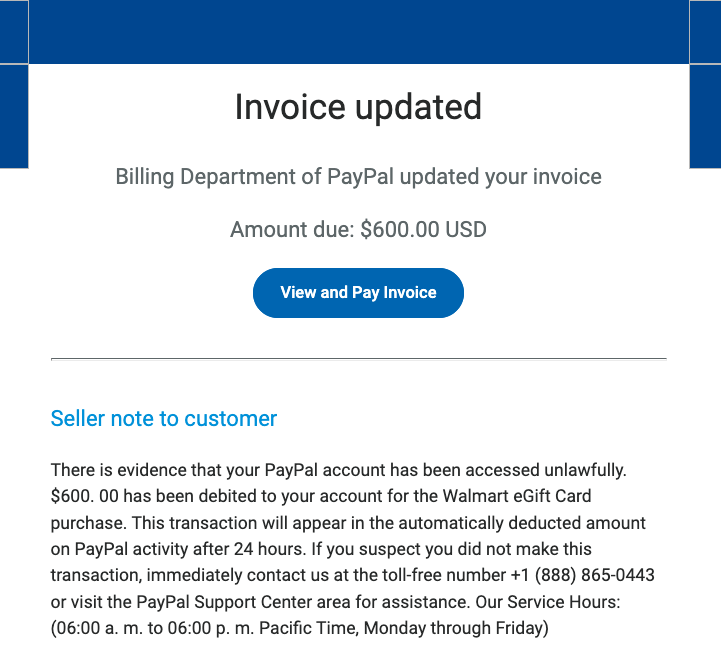 I have been a user of Paypal ever since, well, forever, but certainly for at least 25 years by my guess. Today I closed my account, thanks to having gotten several invoices from fraudsters. Today I got an invoice that I couldn’t delete. {“An error has occurred” … no kidding. I felt a great disturbance in the force.) Brian Krebs wrote about this trend last year.
I have been a user of Paypal ever since, well, forever, but certainly for at least 25 years by my guess. Today I closed my account, thanks to having gotten several invoices from fraudsters. Today I got an invoice that I couldn’t delete. {“An error has occurred” … no kidding. I felt a great disturbance in the force.) Brian Krebs wrote about this trend last year. I have been a user of Paypal ever since, well, forever, but certainly for at least 25 years by my guess. Today I closed my account, thanks to having gotten several invoices from fraudsters. Today I got an invoice that I couldn’t delete. {“An error has occurred” … no kidding. I felt a great disturbance in the force.) Brian Krebs wrote about this trend last year.
I have been a user of Paypal ever since, well, forever, but certainly for at least 25 years by my guess. Today I closed my account, thanks to having gotten several invoices from fraudsters. Today I got an invoice that I couldn’t delete. {“An error has occurred” … no kidding. I felt a great disturbance in the force.) Brian Krebs wrote about this trend last year. These calls are made on pre-paid phone cards, which have largely replaced the collect calls that were once the mainstay of the prison population’s communications. Remember dialing 0 to get the operator? That is no longer an option as of this year for non-landline AT&T customers. Sadly, this means few people will remember Ernestine, that lovable character by Tomlin.
These calls are made on pre-paid phone cards, which have largely replaced the collect calls that were once the mainstay of the prison population’s communications. Remember dialing 0 to get the operator? That is no longer an option as of this year for non-landline AT&T customers. Sadly, this means few people will remember Ernestine, that lovable character by Tomlin.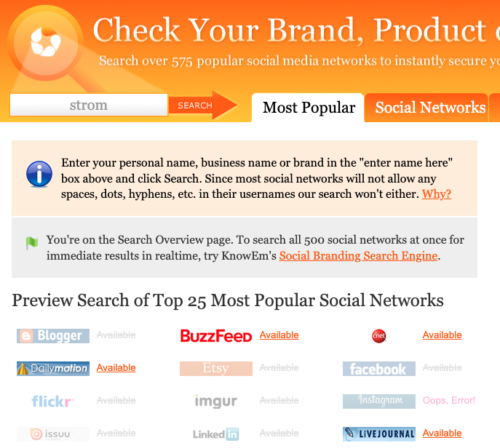 My favorite and initial go-to for this research is Knowem.com. It allows you to search through 500 popular social networks, along with over 150 domain extensions, and the entire USPTO Trademark database. You can quickly figure out what has been taken, and what is still available. The domain extension search is focused on the country-specific ones, which it arranges by continent. It only shows you whether or not a domain is available.
My favorite and initial go-to for this research is Knowem.com. It allows you to search through 500 popular social networks, along with over 150 domain extensions, and the entire USPTO Trademark database. You can quickly figure out what has been taken, and what is still available. The domain extension search is focused on the country-specific ones, which it arranges by continent. It only shows you whether or not a domain is available.
 eventually became the BlackBerry. It worked with a one-pound radio and a one pound HP palmtop.
eventually became the BlackBerry. It worked with a one-pound radio and a one pound HP palmtop.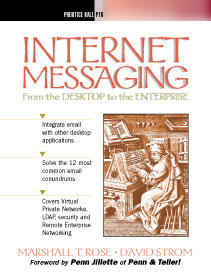 book with Marshall Rose, the inventor of the POP protocols. The book covered the more popular email programs at the time, which included Lotus cc:Mail (extinct), Netscape Messenger (extinct but replaced by Thunderbird you could say), Eudora Pro (still very much
book with Marshall Rose, the inventor of the POP protocols. The book covered the more popular email programs at the time, which included Lotus cc:Mail (extinct), Netscape Messenger (extinct but replaced by Thunderbird you could say), Eudora Pro (still very much  My stepson died last year of throat cancer, brought on by years of alcohol and tobacco abuse. I say this because I thought this was going to be a hard book to read — part memoir, part 12-step navigational handbook, part Big Thoughts. That doesn’t sound like I liked the book, but I did, and thought Levy spoke to me about my stepson and his various demons that he fought and lost. She fought and has won, but it was a hard fight, filled with many missteps and disastrous mistakes.
My stepson died last year of throat cancer, brought on by years of alcohol and tobacco abuse. I say this because I thought this was going to be a hard book to read — part memoir, part 12-step navigational handbook, part Big Thoughts. That doesn’t sound like I liked the book, but I did, and thought Levy spoke to me about my stepson and his various demons that he fought and lost. She fought and has won, but it was a hard fight, filled with many missteps and disastrous mistakes.![Sam: A Novel by [Allegra Goodman]](https://m.media-amazon.com/images/W/WEBP_402378-T2/images/I/41XMhRgw6qL.jpg)
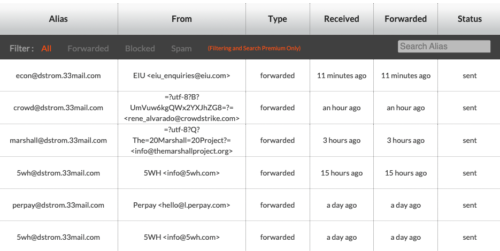 Here are three providers you should check out: DuckDuckGo’s @duck.com, 33Mail.com, and Yahoo.com. All three are available for free (and the latter two also offer paid plans) and work reasonably well. My favorite is 33Mail, which I have been an avid user of their free account for many years now and have set up dozens of aliases. The setup process is nothing: you just start using “something@youraccount.33mail.com” and the service takes care of getting the message forwarded to your real email. The forever free version has unlimited aliases, which is handy because it shows you the alias used at the top of your message, in case you want to send all inbound mail using that alias to the bit bucket. You can sign into the web portal of your account and view the transaction log shown here as well as the status of the various aliases that have been used to forward mail to you, and those emails that you have blocked. The free account does come with bandwidth limits, which I have never come close to reaching. There are
Here are three providers you should check out: DuckDuckGo’s @duck.com, 33Mail.com, and Yahoo.com. All three are available for free (and the latter two also offer paid plans) and work reasonably well. My favorite is 33Mail, which I have been an avid user of their free account for many years now and have set up dozens of aliases. The setup process is nothing: you just start using “something@youraccount.33mail.com” and the service takes care of getting the message forwarded to your real email. The forever free version has unlimited aliases, which is handy because it shows you the alias used at the top of your message, in case you want to send all inbound mail using that alias to the bit bucket. You can sign into the web portal of your account and view the transaction log shown here as well as the status of the various aliases that have been used to forward mail to you, and those emails that you have blocked. The free account does come with bandwidth limits, which I have never come close to reaching. There are 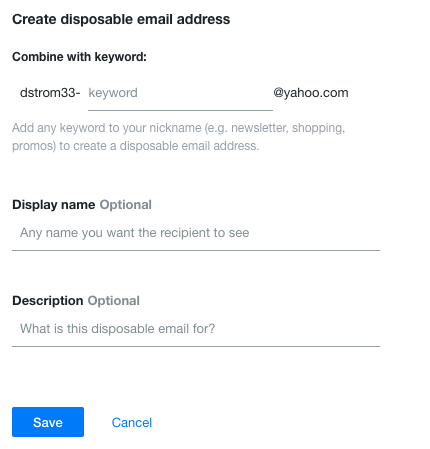 Finally, there is Yahoo. Remember them? Remember both of their massive data breaches back in the day? Well, it has been years since I used them for anything other than a spam collector, and the free version immediately begins placing ads in the form of a rolling series of messages at the top of your inbox. (You can remove these if you upgrade to a paid plan.) You can setup three aliases (what Yahoo calls “keywords”) on your account, using this menu shown here. It isn’t as convenient as 33Mail, and of course you need a Yahoo email address for this to work.
Finally, there is Yahoo. Remember them? Remember both of their massive data breaches back in the day? Well, it has been years since I used them for anything other than a spam collector, and the free version immediately begins placing ads in the form of a rolling series of messages at the top of your inbox. (You can remove these if you upgrade to a paid plan.) You can setup three aliases (what Yahoo calls “keywords”) on your account, using this menu shown here. It isn’t as convenient as 33Mail, and of course you need a Yahoo email address for this to work.